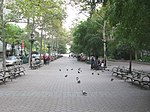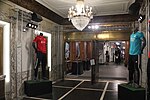Church of St. Mary the Virgin (Manhattan)

The Church of Saint Mary the Virgin is an Episcopal Anglo-Catholic church in Midtown Manhattan, New York City, which is part of the Episcopal Diocese of New York of the Episcopal Church in the United States of America. The church complex is located in the heart of Times Square at 133-145 West 46th Street, with other buildings of the complex at 136-144 West 47th Street, between Sixth and Seventh Avenues. It is colloquially known as "Smoky Mary's" because of the amount of incense used in the services.Completed in 1895, the church has been called "one of the finest Gothic-inspired designs of New York's late 19th century". It was designated a New York City landmark in 1989 and added to the National Register of Historic Places in 1990.
Excerpt from the Wikipedia article Church of St. Mary the Virgin (Manhattan) (License: CC BY-SA 3.0, Authors, Images).Church of St. Mary the Virgin (Manhattan)
West 46th Street, New York Manhattan
Geographical coordinates (GPS) Address Website External links Nearby Places Show on map
Geographical coordinates (GPS)
| Latitude | Longitude |
|---|---|
| N 40.758333333333 ° | E -73.983611111111 ° |
Address
Church of Saint Mary the Virgin
West 46th Street 145
10036 New York, Manhattan
New York, United States
Open on Google Maps






